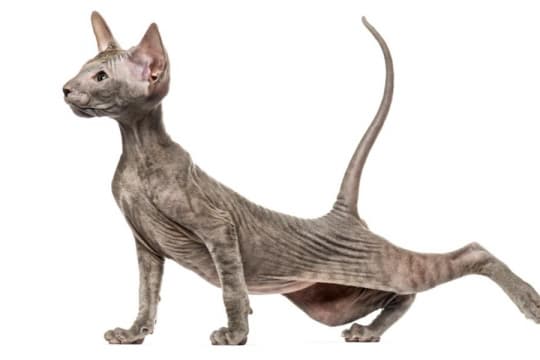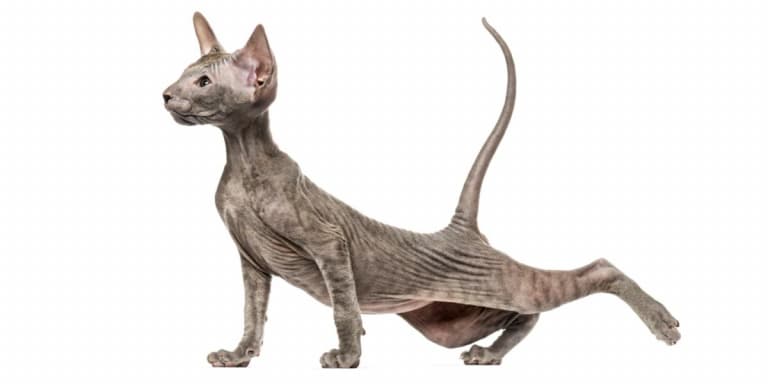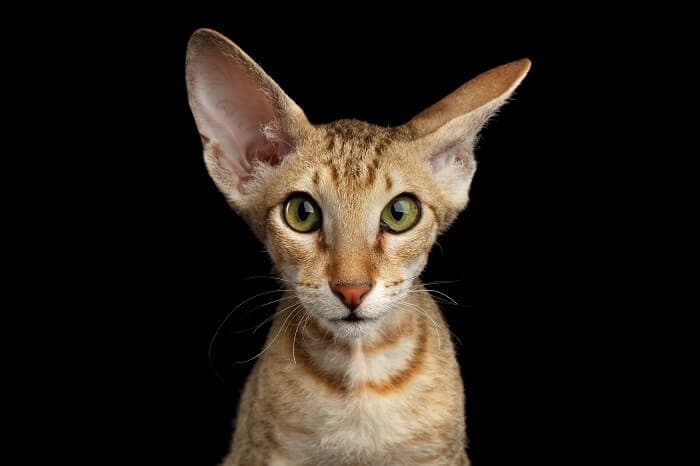
peterbald
Loyal, affectionate, inquisitive, dog-like
Overview
Origin
Russia
Life Span
10-12 years
Height
8"- 10"
Weight
6-10 pounds
Group
Medium-sized hairless
Price
$1700-$3000
History

In 1994, a cat breeder in St. Petersburg, Russia decided to create a brand-new breed that represented the best of two of her favorites. Olga Mironova successfully crossed a hairless Donskoy with an Oriental Shorthair, creating a kitty that resembled the Sphynx, but that was in fact genetically closer to an oriental Shorthair with a hair-losing gene.
The Russian Selectional Feline Federation (SFF) accepted the Peterbald cat in 1996. The International Cat Association (TICA) gave its approval in 1997, and the World Cat Federation (WCF) accepted the breed in 2003. The American Cat Fanciers Association ACFA) accepted the Peterbald in 2008. The breed is gaining popularity worldwide thanks to its outstanding personality, however it is relatively rare in comparison with other cat breeds.
Care

Nutrition
Peterbald cats don't have any special nutritional needs, however they do require a high-quality diet that incorporates real fish or meat as the number one ingredient. Depending on activity level, these kitties might need a bit more food then the average cat simply because they burn more calories with all of their antics.
Grooming
Like all other hairless cats, the Peterbald requires occasional bathing. This is necessary because there is not enough hair to absorb all of the oils the skin produces. Excess oil attracts dirt, leading to irritation and odor. A gentle shampoo and a warm, soft place to dry are two essentials Peterbald cat families will want to have on hand.
Exercise
You will not have to encourage the Peterbald cat to play! These frolicsome kitties retain their youthful exuberance well into adulthood and are always ready to have fun with a friend or on their own. A tall cat tree is essential, as are scratching posts and a basket full of toys.
Health
Peterbald cats have a reputation for good health overall, however some individuals are prone to a skin condition called feline ectodermal dysplasia. Even without this painful skin condition, these kitties are prone to injury if subjected to rough treatment by kids, competitive cats, or overeager dogs.
Breed Standard

Body
The body should be long and graceful with firm, well-developed musculature. The hips and shoulders should be of equal width.
Head
The Peterbald cat’s head should for a long, inverted triangle that extends from the tips of the ears to the point formed by the cat’s chins. The muzzle should form a blunt wedge, with no whisker pinch. Whisker pads may be evident.
Eyes
The Peterbald cat’s eyes should be of medium size with a near almond shape. All eye colors are acceptable and eye color is independent of coat color.
Ears
The ears should be extra-large, with wide bases and pointed tips.
Color
Peterbald cats may be of any color. Lockets are permitted.
Coat
The Peterbald may be completely hairless, or might display a fine coat described by Peterbald breed standards as chamois, flock, brush, or straight. Cats with full, straight coats are not accepted in the show ring.
Tail
The tail should be long and whippy, with a finely tapered end.
Legs & Paws
The legs should be long, with medium to fine bones. The hind legs should be slightly longer than the forelegs. The paws should be medium-sized, with an oval shape and long, prominent toes.
Personality & Temperament

What do you get when you cross an Oriental shorthair with a Donskoy cat? A Peterbald cat! These whimsical creatures are easy to care for, with fun-loving, spirited personalities, and looks that can only be described as uniquely adorable.
The Peterbald cat has a sense of loyalty that many other felines simply don't possess: in fact, this cat is often compared to a dog simply because it is so affectionate toward its humans.
These cats are incredibly sociable, and will happily greet newcomers rather than hiding suspiciously when friends come to call. Because of their social nature, they are unhappy when left alone, meaning it's very important to provide constant companionship. The good news is that companionship doesn't have to be human: Peterbald cats are very similar to their Oriental cousins in that they can form close bonds with other felines and dogs.
Peterbald cats are playful and athletic. They spend their waking hours investigating everything, helping their favorite humans with chores, and looking for tall vantage points from which to survey their domain. They have a tendency to talk while they're at it, loudly expressing their opinions on everything from the amount of attention you're giving them to the fact that they require more food in their dish.
While the Peterbald cat might not be the ideal pet for everyone, this breed is a fascinating one. Those who are lucky enough to bring a Peterbald kitten home have a loyal friend for life!